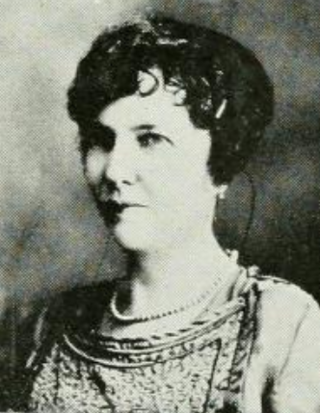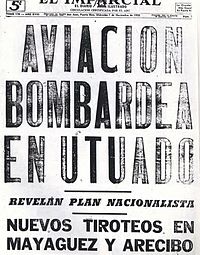
El Nuevo Día is the newspaper with the largest circulation in Puerto Rico. It is considered mainstream and the territory's newspaper of record. It was founded in 1909 in Ponce, Puerto Rico, and today it is a subsidiary of GFR Media. Its headquarters are in Guaynabo, Puerto Rico.

The Ponce massacre was an event that took place on Palm Sunday, March 21, 1937, in Ponce, Puerto Rico, when a peaceful civilian march turned into a police shooting in which 17 civilians and two policemen were killed, and more than 200 civilians wounded. None of the civilians were armed and most of the dead were reportedly shot in their backs. The march had been organized by the Puerto Rican Nationalist Party to commemorate the abolition of slavery in Puerto Rico by the governing Spanish National Assembly in 1873, and to protest the U.S. government's imprisonment of the Party's leader, Pedro Albizu Campos, on sedition charges.

Luis Palés Matos was a Puerto Rican poet who is credited with creating the poetry genre known as Afro-Antillano. He is also credited with writing the screenplay for the "Romance Tropical", the first Puerto Rican film with sound.

Bolívar Pagán Lucca was a Puerto Rican historian, journalist, and politician.

Blanton C. Winship was an American military lawyer and veteran of both the Spanish–American War and World War I. During his career, he served both as Judge Advocate General of the United States Army and as the governor of Puerto Rico. An investigation led by the United States Commission on Civil Rights blamed him for the Ponce massacre, which killed 19 people.
Adolfo de Hostos served in the mid twentieth century, from January 1936 to 1950, as the fifth Official Historian of Puerto Rico, a position created in March, 1903, by the Puerto Rico Legislature.
Luis Germán Cajiga is Puerto Rican painter, poet and essayist known for his screen printing depicting Puerto Rico's natural landscape, its creole culture, and religious motifs. He was born in 1934, in the municipality of Quebradillas, Puerto Rico, and his studio is currently based in the Old San Juan.
Nemir Matos Cintrón is a Puerto Rican author who resides in Florida. She has published several books of poetry and parts of a novel. She has openly thematized her lesbianism in much of her work.

Manuel Ramos Otero was a Puerto Rican writer. He is widely considered to be the most important openly gay twentieth-century Puerto Rican writer who wrote in Spanish, and his work was often controversial due to its sexual and political content. Ramos Otero died in San Juan, Puerto Rico, due to complications from AIDS.

Guillermo Vivas Valdivieso was a Puerto Rican attorney, journalist, politician and Mayor of Ponce, Puerto Rico from 1925 to 1928.
Washington Lloréns Lloréns was a Puerto Rican writer, linguist, lexicographer, journalist and literary critic. Trained as a pharmacist and chemist, he applied his knowledge of science to vocabulary and linguistics, for which he had a passion. As a lexicographer, one of his notable achievements was the inclusion of over 50 Puerto Rican words in the nineteenth edition of the Dictionary of the Royal Academy of the Spanish Language in 1970.
José Lloréns Echevarría was Mayor of Ponce, Puerto Rico, for three days, from 8 November 1898 to 10 November 1898.

El Ponceño, founded in 1852, was the first newspaper published in Ponce, Puerto Rico. The paper was originally named "El Observador Ponceño" but it was shortened to "El Ponceño".
Epifanio “Fano” Irizarry Jusino was a Puerto Rican oil canvas painter, draftsman, and art professor from Ponce, Puerto Rico. He exposed Costumbrismo practices of his native Puerto Rico, including bomba and plena dances, cockfighting and carnivals. During his professional lifetime, he exhibited in Puerto Rico, the United States as well as Europe, some of which were solo, and he was the winner of various prestigious awards.
The following is a timeline of the history of the municipality of Mayagüez, Puerto Rico.
Guillermo A. Baralt is a Puerto Rican historian. He obtained his bachelor's degree from Duquesne University in 1970. Later he continued his studies in the University of Chicago where he earned his Master's and Doctor's degrees. He is currently professor of History at the University of Puerto Rico at Rio Piedras. He is a member of Phi Sigma Alpha fraternity.

Milagros Benet de Mewton was a Puerto Rican educator, women's rights advocate and suffragist. Born into an intellectual, liberal family, Benet trained as a teacher. Inhabitants of the island gained U.S. citizenship in 1917, two decades after the United States acquired Puerto Rico from Spain in the Spanish–American War. Benet was active in the struggle for women's enfranchisement and joined the first suffragist organization Liga Femínea Puertorriqueña that year. When U.S. women gained the right to vote with the passage of the 19th Amendment in 1919, Benet led the push to extend its coverage to Puerto Rico. In 1924, she filed a lawsuit challenging the right of the electoral board to refuse to register women as they were U.S. citizens. The Supreme Court of Puerto Rico ruled that states and territories have the right to determine who can vote and denied her claim.
WITA-TV was a television station on ultra high frequency (UHF) channel 30 in San Juan, Puerto Rico. It was owned by El Imparcial newspaper and broadcast in English. The station operated from June 1966 to June 1967; the underlying permit continued for several years and was sold to United Hemisphere TV of Puerto Rico but never reactivated. The Federal Communications Commission later voided the sale. The newspaper also held construction permits for UHF stations in Ponce and Mayagüez that were included in the sale but never built.








